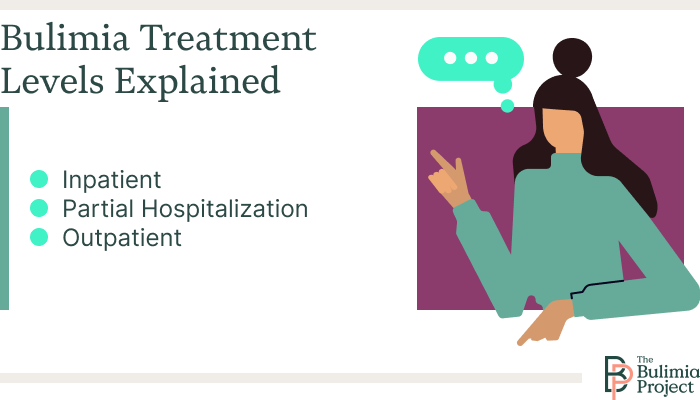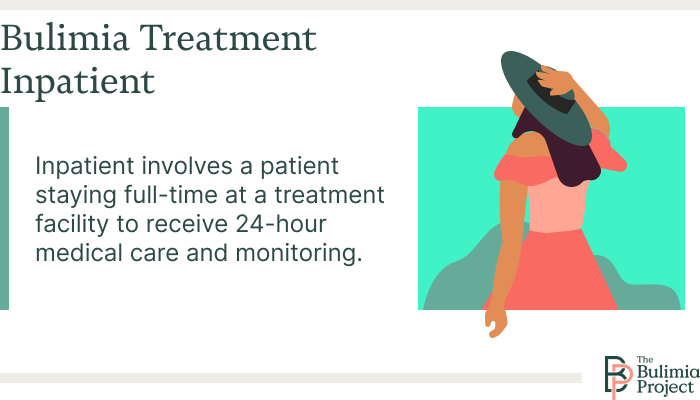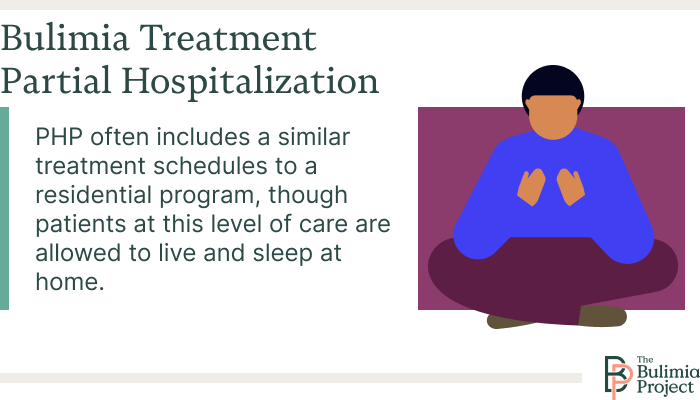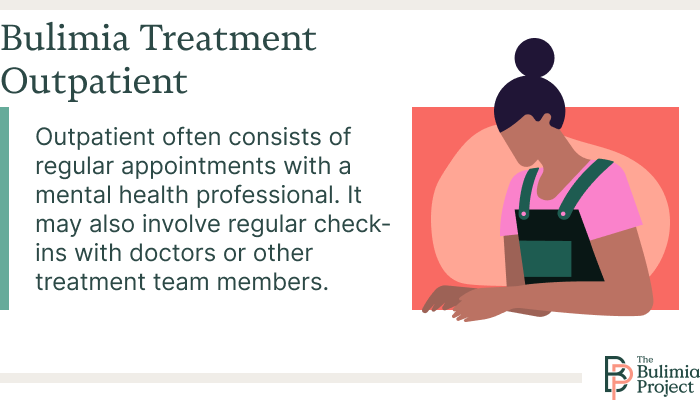This can make it feel overwhelming when looking for the best bulimia care, but the most effective treatment for bulimia nervosa is the one that restores your physical and mental health while keeping you safe.
When creating a treatment plan, it’s important to incorporate physicians, therapists, nutritionists, and other treatment team members to create something that best serves your specific history and needs. Other considerations, like insurance coverage, should also be kept in mind to ensure the best experience possible.
Bulimia Treatment Levels Explained
While all bulimia cases require appropriate attention, there are various levels of care that can help treat these conditions to cater to cases that require more or less medical supervision.
BN treatment settings range from very intensive to essentially supplementary, and many people will work through several levels of care as their eating habits improve and they continue making progress toward recovery.1
Inpatient care is the most intensive type of treatment for bulimia nervosa, or other eating disorders like binge eating disorder (BED) or anorexia nervosa (AN). It involves a patient staying full-time at a treatment facility to receive 24-hour medical care and monitoring.
Inpatient hospitalization is generally reserved for the most severe cases. Patients receiving this type of care are nearly always experiencing some type of mental or physical health crisis or other serious health complications that could be an immediate threat to their lives. As such, stays are often short, with the overall goal of inpatient hospitalization helping someone become medically stable.2
Once someone has moved beyond the physical symptoms of immediate health concerns, they and their treatment team can begin considering more mental health-oriented and long-term goals. That’s the role of residential eating disorder treatment.
The schedule is also intensive, involving anything from individual and group therapy sessions, meal monitoring, medical check-ins, and nutritional counseling on a regular basis. However, the setting is much more relaxed and intended for longer-term stays, with most patients remaining in this type of care for a minimum of 30 days.2
Partial hospitalization programs (PHPs) are another intensive method for treating eating disorders. They often include similar treatment schedules to residential programs, though patients at this level of care are allowed to live and sleep at home, which is why PHPs are sometimes referred to as “day programs.”
But that doesn’t mean the schedule is restful. A PHP can last up to 5 days per week, for 10 hours per day, or sometimes more.2 The extensive work being done still makes this a helpful level of care for those still experiencing severe disordered thoughts and behaviors, and sometimes those who could be recommended for residential care attend PHPs instead due to considerations around cost or familial responsibilities.2
Still, as someone progresses toward recovery, their schedules are usually adjusted to reflect the current amount of medical supervision they need.
Outpatient care is the least intensive form of care for bulimia nervosa. It often consists of a regular appointment with a mental health professional, like a therapist. It may involve regular check-ins with doctors or other treatment team members, especially if patients were prescribed medication as part of their care routine.
Otherwise, people at this level of care are living and sleeping at home and are generally able to perform their social responsibilities without struggling with their eating disorder symptoms.3
Those needing extra support at this stage may also benefit from an intensive outpatient program (IOP). This hybrid model involves treatment sessions that take place several times a week, for several hours at a time, but still allow for ample personal time when someone can practice new coping mechanisms on their own or continue going to work or school.3
Which Treatment Solution is Best for Me?
Your treatment program should be tailored to meet your individual needs. No program is right for every person or even for the same person at every stage of recovery.
Your treatment team will find the best care setting for you based on some of these factors:4
- Symptom severity
- How long you’ve lived with bulimia
- Overall mental health, including co-existing conditions like depression and anxiety
- Your support system and home environment
- Your motivation to get better
- Overall medical stability
- Location, including the availability of treatment programs near you
The best and most direct way to have bulimia nervosa treated is to see a medical professional. Your primary care physician, therapist, or another expert may be able to give you an official diagnosis and begin to figure out the type of treatment program that may be most helpful for your individual situation.
How Do Doctors Determine the Best Bulimia Treatment Settings?
Doctors use many tools to help diagnose people with bulimia nervosa and understand the best possible treatment setting for each patient.
If you visit a doctor to be evaluated, they may determine a diagnosis based on:5
- A physical exam
- Talking to you about your eating habits, physical symptoms, and methods you may use for losing or controlling weight
- A psychological evaluation, to help determine attitudes around body image
- Certain medical tests, including blood tests and cardiograms
The Diagnostic and Statistical Manual of Mental Disorders, Fifth Edition (or DSM-5), is the record of all officially recognized mental health disorders, and many doctors use this to determine when someone meets the medical criteria for bulimia. The DSM also has guidelines on assigning case severity, which helps inform treatment recommendations.
Additional Bulimia Treatment Considerations
Aside from which level of care may serve you best, there are other considerations to keep in mind when thinking of the best way to treat bulimia.
Insurance is often the biggest concern for people looking for help. And there’s a good reason: Treatment can be expensive for those who aren’t covered.
It’s essential to get a formal diagnosis from a doctor before you consider enrolling in a bulimia treatment program. Without this diagnosis, it is unlikely that insurance will cover the cost of your care. With the diagnosis, your care is deemed medically necessary.
You should also check exactly what and how much treatment your plan may cover. Some insurance policies only pay for a certain number of treatment sessions or types of therapy considered “evidence-based.”
Contacting a representative from your insurance company could be a good first step to discuss these considerations and ask for the names of any doctors or programs in their network and, therefore, be more easily covered.
Your insurance company should work with you to cover your care. But you may still face unexpected expenses due to these issues:
- Limits: Your insurance plan could cap how long you can stay in treatment. And some cap on how much coverage you can use for any medical condition, including an eating disorder.
- Settings: Some insurance plans balk at inpatient care costs, and they entice members to move home as soon as possible. They may require you to attempt outpatient treatment before they cover the cost of inpatient care.
- Copayments: Some plans require you to pay a portion of your treatment costs. Paying a set amount each visit is common, and insurance will cover the remainder of the bill.
- Deductibles: Most plans require you to spend a set amount before they’ll pay anything. Once you hit this deductible amount, your coverage will kick in.
All of these fees could make your bulimia treatment costs rise. Talk with your insurance company, doctor, and treatment team before care begins so you know what to expect. And if you see a bill you don’t understand, speak up right away.
If the total still seems pricy, or if you don’t have insurance, you can also speak with the treatment center directly. They may have options to make the out-of-pocket cost of care easier for you to manage. Some centers offer payment plans where you can finance the cost of your care over time. You might not even have to begin making payments until you leave treatment.
What Comes Next?
If you or a loved one are struggling with bulimia nervosa, it’s important to seek out help.
Talk with your doctor about your feelings or symptoms and ensure that you have a diagnosis documented in your medical record. Ask your doctor what treatment setting is right for you, and ask your insurance company what providers offer covered care.
If you’re too unwell to tackle these steps alone, don’t worry. Ask your doctor, treatment provider, or close friend to help. You deserve to get the treatment you need.
With the right support and care, you can get the bulimia treatment you need to get well and live a healthier life.
Resources
- Eating Disorders. (n.d.). National Institute of Mental Health. Accessed January 2024.
- Levels of Care. (n.d.). University of California, San Diego. Accessed January 2024.
- Types of Treatment. (n.d.). National Eating Disorders Association. Accessed January 2024.
- Harrington B, Jimerson M, Haxton C. et al. (2015). Initial Evaluation, Diagnosis, and Treatment of Anorexia Nervosa and Bulimia Nervosa. American Family Physician; 91(1):46-52.
- Bulimia nervosa. (n.d.). Mayo Clinic. Accessed January 2024.



